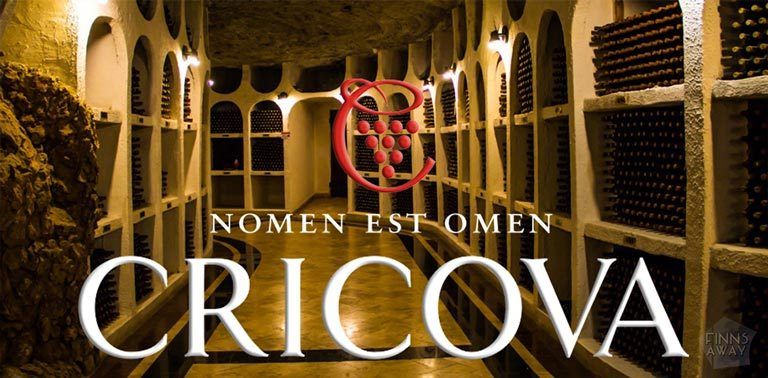
Moldova wineries and our visit to Cricova
History and culture of wine making in Moldova is ancient, and it makes Moldova an astonishing, yet still somewhat unknown wine country. Moldova’s wine regions are situated in the same latitude than several wine areas in France for example, and territory with low hills and sunny plateaus is perfect for wine production. Over 400 million liters of wine is produced yearly on 112 thousand hectares of vineyards, out of which 67 million bottles is exported.
Wine in Moldova comes with huge variety. There are excellent reds, whites and roses from crispy dry to sweet, sparkling wine made with traditional methods and a special, aged brandy called The Divin. Moldova’s wine cellars are legendary; did you know that the largest wine cellars in the whole world are in Moldova? Milestii Mici winery actually holds two Guinness World Records with the longest underground cellars (total length of the tunnels is 200 km!) and the largest wine collection stored in cellars. I won’t even try to collect here all-you-need-to-know about Moldovian wine, there are lot of sites like wineofmoldova where you can gather more information over this amazing wine country.
Foreign tourists coming to Moldova are often interested in visiting one or more of the big wineries, that open their doors for tours and tastings. Several famous wineries are conveniently located close to capital Chisinau, and thus make excellent destinations for a day trip.
Our tour in Cricova wine cellars
During our stay in Chisinau, we were invited to visit the famous Cricova winery (Combinatul de Vinuri Cricova S.A.), located in a small town of Cricova 15 km from the capital. Cricova winery was founded in 1952 and is famous for producing excellent sparkling wines, and of course for its wine cellars. They compete with Milestii Mici of the tittle of worlds longest wine cellars; Cricova holds the record for having the largest cellar area in use for actual wine storing and production. Total length of Cricova cellars is astonishing 120 km, out of which 80 km is in use at the moment. The tunnels were dug back in 15th century, when limestone was carved to build Chisinau, and are as deep as 100 meters. The limestone carving is still a work in process, so the cellars are even growing.
We participated an English tour on one sunny Friday with dozen of other visitors. Our tour guide Cristina was very professional and spoke excellent English, so it was easy to follow the presentation. The tour in the cellars is done by a charming electric mini-train, and covers around 6 km of the main tunnels. Cellar tunnels are actually called the streets of an underground city, and each has a name according to wine varieties, like Chardonney or Cabernee.
The maturing section
First stop of the tour was in the wine maturation area with huge amount of barrels. Oak barrels are bought from abroad and in use here for 5 years, after which they are re-used in cognac production elsewhere. Average maturation time in barrels is 5 to 6 months for white wines and 1 to 3 years for red wines. In addition to almost thousand oak barrels in different sizes, there are 1,5 thousand huge metal barrels in use as well.
The sparking wine production section
Next we continued down to 100 meters below ground to the so-called champagne station. This is where the Cricova’s vin spumant is produced, using technology called “Méthode Traditionnelle” which is the same that is used in France for champagne. The first fermentation is similar to other wines, but there is a second fermentation phase after bottling the base wine. Maturation time for Cricova sparkling wines is from 1-3 years up to 5 years for some quality variants.
After bottling there is a phase called riddling, when bottles are held in racks, in upside down positions starting from 45 degrees, and the angle is gradually increased. When in the racks, the bottles are twisted daily, which, together with quality controlling, is mostly a manual process. There are also machines that can be used for twisting over 500 bottles at once, but only the manual work enables checking closely the status of each bottle.
Endless rows of racks are a wonderful sight, they hold together half a million bottles of the sparkling delicacy of Cricova. After riddling phase is completed, the sediment, called lees, is removed from the top of the bottle together with the temporary metal cap, and some sugar is added. Final corking is done with oak corks from Portugal, and all bottles go through an inspection station with capacity of 1500 bottles an hour.
The underground cinema and the national collection
Next stop after the amazing champagne station was the Cricova underground cinema (yes, there is a movie theater in the cellars!) 80 meters below ground level. Accompanied by a glass of Cricova sparkling wine we watched an excellent film about Cricova – you can also check it out from the end of the post! Then we continued to the storage section with special collections of wines.
There is a small museum and a wineglass-shaped cellar section with around 600 storage spaces called casas. They hold immeasurably valuable wine collections and some very special bottles like the ”Jerusalem of Easter” from 1902, one of its kind left in the world. There is a long row of casas belonging to politicians and other celebrities who have visited the cellars. Among them are for example Angela Merkel and Vladimir Putin, who celebrated his 50th birthday in Cricova.
Tasting rooms and a souvenir shop
At the end of the tour we took a look at the marvelous tasting rooms in the cellars, 50 meters underground. There are several beautifully decorated halls, where not only wine tastings, but also meetings and festivities are held. Those visitors who have booked a tour with tasting are directed to the tables here, and others can visit a small wine shop before leaving the amazing cellars behind. We bought a bottle of Cricova Brut Roz sparkling wine, which later proved to be an excellent choice, and cost just 80 MDL, which is around 4 euros. Total duration of the tour without tasting was about 1,5 hours.
How to visit Cricova cellars?
If you are planning to visit Cricova winery, you can either buy a tour from a tour operator in Chisinau (which is an expensive option), or you can do it easily yourself by booking the tour ahead via winery website and getting there by public transportation. There are frequent buses (leaving in about every 20 minutes) to Cricova from Chisinau; hop in a bus number 2 from the corner of Strada Vasile Alecsandri and Strada Alexandru cel Bun. Tickets are paid in the bus to a cashier, and one ticked costs 4,5 MDL which is only 0,2 € (Sep 2017).
The drive to Cricova takes about 30 minutes. You should exit the bus in a stop called Cricova Primaria in the town center (this is where most of the people get out of the bus, but if you miss it and are still in when the bus turns left after the center, just wait until it loops back to the same point). Then it’s just around 1 km walk down to the visitor center and wine cellars. There are signs pointing you to the right direction in case you are not using a navigator. You should wear some warm clothes for the tour, since the temperature in the cellars is 12 to 14 degrees only.
Some other famous Moldovan wineries open for visitors
Chateau Cojusna
This large winery situated just 15 km from Chisinau is specialized in dessert wines and brandies. Wine tastings are held in a Middle Ages themed hall, and also here you can visit underground cellars.
Milestii Mici
Only 18 km from Chisinau, Milestii Mici is a popular wine tour destination. The world famous, huge cellars called underground city surely are worth exploring. For tours in vineyards you should arrive by your own vehicle.
Purcari
Situated in south, 120 km from Chisinau, Purcari winery has one of the oldest and most famous cellars in Moldova, and produces quality wines from European and Moldovan grapes. For wine tourists there is a hotel with luxury rooms, restaurants and lot of activity possibilities.
For real wine enthusiast there are a lot of other wineries to explore on top of these most popular ones mentioned here. And in addition to the actual wineries, many Moldovians produce their own wines at home. Rows of vine are a common sight in courtyards in the countryside.
The highlight of the year for wine tourists and locals alike is the ”National Wine Day”, Moldovan wine festival. The main event takes place in Chisinau on the first weekend of October. Undoubtedly an amazing experience, which we now slightly missed, but who knows if we will be back some other year.
